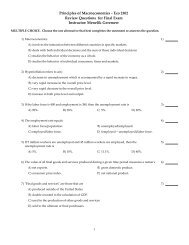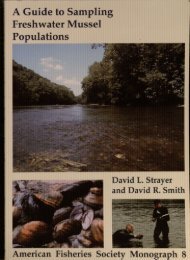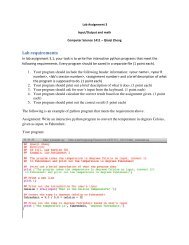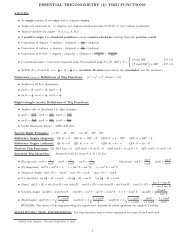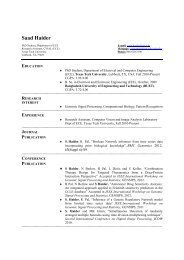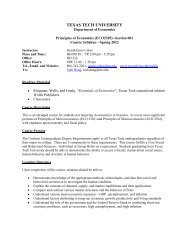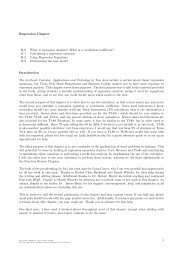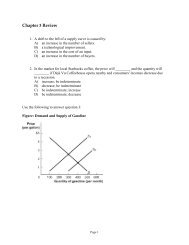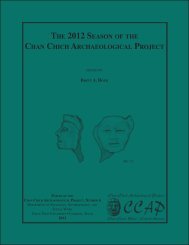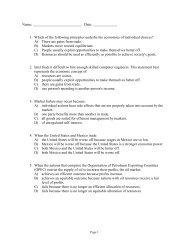Supplement for Manifolds and Differential Geometry Jeffrey M. Lee
Supplement for Manifolds and Differential Geometry Jeffrey M. Lee
Supplement for Manifolds and Differential Geometry Jeffrey M. Lee
Create successful ePaper yourself
Turn your PDF publications into a flip-book with our unique Google optimized e-Paper software.
28 0. Background Material<br />
0.7. <strong>Differential</strong> Calculus on Banach Spaces<br />
Modern differential geometry is based on the theory of differentiable manifoldsa<br />
natural extension of multivariable calculus. Multivariable calculus is said<br />
to be done on (or in) an n-dimensional coordinate space R n (also called<br />
variously “Euclidean space” or sometimes “Cartesian space”. We hope that<br />
the great majority of readers will be com<strong>for</strong>table with st<strong>and</strong>ard multivariable<br />
calculus. A reader who felt the need <strong>for</strong> a review could do no better<br />
than to study the classic book “Calculus on <strong>Manifolds</strong>” by Michael Spivak.<br />
This book does multivariable calculus 3 in a way suitable <strong>for</strong> modern differential<br />
geometry. It also has the virtue of being short. On the other h<strong>and</strong>,<br />
calculus easily generalizes from R n to Banach spaces (a nice class of infinite<br />
dimensional vector spaces). We will recall a few definitions <strong>and</strong> facts<br />
from functional analysis <strong>and</strong> then review highlights from differential calculus<br />
while simultaneously generalizing to Banach spaces.<br />
A topological vector space over R is a vector space V with a topology<br />
such that vector addition <strong>and</strong> scalar multiplication are continuous. This<br />
means that the map from V × V to V given by (v 1 , v 2 ) ↦→ v 1 + v 2 <strong>and</strong> the<br />
map from R × V to V given by (a, v) ↦→ av are continuous maps. Here we<br />
have given V × V <strong>and</strong> R × V the product topologies.<br />
Definition 0.34. A map between topological vector spaces which is both<br />
a continuous linear map <strong>and</strong> which has a continuous linear inverse is called<br />
a toplinear isomorphism.<br />
A toplinear isomorphism is then just a linear isomorphism which is also<br />
a homeomorphism.<br />
We will be interested in topological vector spaces which get their topology<br />
from a norm function:<br />
Definition 0.35. A norm on a real vector space V is a map ‖.‖ : V → R<br />
such that the following hold true:<br />
i) ‖v‖ ≥ 0 <strong>for</strong> all v ∈ V <strong>and</strong> ‖v‖ = 0 only if v = 0.<br />
ii) ‖av‖ = |a| ‖v‖ <strong>for</strong> all a ∈ R <strong>and</strong> all v ∈ V.<br />
iii) If v 1 , v 2 ∈ V, then ‖v 1 + v 2 ‖ ≤ ‖v 1 ‖+‖v 2 ‖ (triangle inequality). A vector<br />
space together with a norm is called a normed vector space.<br />
Definition 0.36. Let E <strong>and</strong> F be normed spaces. A linear map A : E −→ F<br />
is said to be bounded if<br />
‖A(v)‖ ≤ C ‖v‖<br />
<strong>for</strong> all v ∈ E. For convenience, we have used the same notation <strong>for</strong> the norms<br />
in both spaces. If ‖A(v)‖ = ‖v‖ <strong>for</strong> all v ∈ E we call A an isometry. If<br />
3 Despite the title, most of Spivak’s book is about calculus rather than manifolds.



